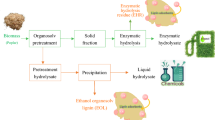Abstract
For the first time, a method of phenol-selective liquefaction is proposed for the fractionation and multilevel conversion of lignocellulose. Through phenol-selective liquefaction, lignin and hemicellulose are liquefied, with large amounts of cellulose retained in the unliquefied residues. Using a phenol/straw ratio of 3 and a sulfuric acid concentration of 3 %, large amounts of hemicellulose (≥85 %) and lignin (≥70 %) can be liquefied at 100 °C in 30 min, with a high quantity of cellulose (≥80 %) retained. Unliquefied residues from selective liquefaction have higher susceptibility for enzymatic attack. Enzymatic hydrolyzation of residues can be as high as 65 % in 48 h with 40.7 FPU/g of dry materials, which can then be used to prepare sugar platform intermediates. The liquefied products of wheat straw are then resinified with formaldehyde in the presence of NaOH as a catalyst and synthesized into phenol formaldehyde-type resins reaching up to GB/T 14732-2006 standards. Phenol selective liquefaction, a new technology for the fractionation of lignocellulose, achieves effective fractionation and multilevel conversion of straw components. Hence, it is an important tool to achieve full utilization of biomass and high value-added conversion of lignocellulose.





Similar content being viewed by others
References
Chen, H. Z. (2008). Biomass science and Engineering. Beijing: Chemistry Industry Press.
Chen, H. Z., & Li, D. M. (2006). Journal of Cellulose Science and Technology, 14, 62–68.
Chen, H. Z., & Wang, L. (2008). Chin. Journal of Process Engineering, 8, 676–681.
Li, H., Yuan, X., Zeng, G., Huang, D., Huang, H., Tong, J., You, Q., Zhang, J., & Zhou, M. (2010). Bioresource Technology, 101(8), 2860–2866.
Jasiukaitytė, E., Kunaver, M., & Strlič, M. (2009). Cellulose, 16(3), 393–405.
Lee, J. U., & Oh, Y. S. (2010). Turkey Journal of Agriculture, 34, 303–308.
Jena, U., Vaidyanathan, N., Chinnasamy, S., & Das, K. (2011). Bioresource Technology, 102(3), 3380–3387.
Wang, M., Leitch, M., & Xu, C. C. (2009). Journal of Industrial and Engineering Chemistry, 15(6), 870–875.
Tymchyshyn, M., & Xu, C. C. (2010). Bioresource Technology, 101(7), 2483–2490.
Jin, Y., Ruan, X., Cheng, X., & Lü, Q. (2011). Bioresource Technology, 102(3), 3581–3583.
Alma, M. H., & Basturk, M. A. (2006). Ind. Crops Production, 24, 171–176.
Yu, F., Liu, Y., Pan, X., Lin, X., Liu, C., Chen, P., & Ruan, R. (2006). Applied Biochemistry and Biotechnology, 129–132, 574–85.
Mun, S. P., & Jang, J. P. (2009). Journal of Industrial and Engineering Chemistry, 15, 743–747.
Mishra, G., & Saka, S. (2011). Bioresource Technology, 102, 10946–10950.
Lee, S. H., Teramoto, Y., & Shiraishi, N. (2002). Journal of Applied Polymer Science, 83, 1473–1481.
Lee, S. H., Teramoto, Y., & Shiraishi, N. (2002). Journal of Applied Polymer Science, 84, 468–472.
Jin, Y., Cheng, X., & Zheng, Z. (2010). Bioresource Technology, 101(6), 2046–2048.
Wang, M., Leitch, M., & Xu, C. (2009). European Polymer Journal, 45(12), 3380–3388.
Robertson, J. B., & Van Soest, P. J. (1981). In W. P. James & T. Theander (Eds.), Analysis of dietary fibre in food, The detergent system of analysis and its application to human foods (pp. 123–158). New York: Marcel Dekke.
Lee, S. H., Yoshioka, M., & Shiraishi, N. (2000). Journal of Applied Polymer Science, 78, 311–318.
Miller, G. L. (1959). Analytical Chemistry, 31, 426–428.
Kubicek, C. (1982). Archives of Microbiology, 132, 349–354.
Sun, F. B., & Chen, H. Z. (2008). Bioresource Technology, 99, 5474–5479.
Chandra, R. P., Bura, R., Mabee, W. E., Berlin, A., Pan, X., & Saddler, J. N. (2007). Biofuels, 108, 67–93.
Lee, S. H., & Ohkita, T. (2003). Wood Sci. Technology, 37, 29–38.
Mosier, N., Wyman, C., Dale, B., Elander, R., Lee, Y. Y., Holtzapple, M., & Ladisch, M. (2005). Bioresource Technology, 96, 673–686.
Zheng, Y., Pan, Z. L., & Zhang, R. H. (2009). International Journal of Agriculture and Biology Engineering, 2, 51–68.
Pan, H., Shupe, T. F., & Hse, C. Y. (2007). Journal of Applied Polymer Science, 105, 3739–3746.
Acknowledgments
This work was financially supported by the National Basic Research Program of China (No. 2011CB707401), the National High Technology Research and Development Program of China (SS2012AA022502), and the National Key Project of Scientific and Technical Supporting Program of China (No. 2011BAD22B02).
Author information
Authors and Affiliations
Corresponding author
Rights and permissions
About this article
Cite this article
Chen, H., Zhang, Y. & Xie, S. Selective Liquefaction of Wheat Straw in Phenol and Its Fractionation. Appl Biochem Biotechnol 167, 250–258 (2012). https://doi.org/10.1007/s12010-012-9675-y
Received:
Accepted:
Published:
Issue Date:
DOI: https://doi.org/10.1007/s12010-012-9675-y




